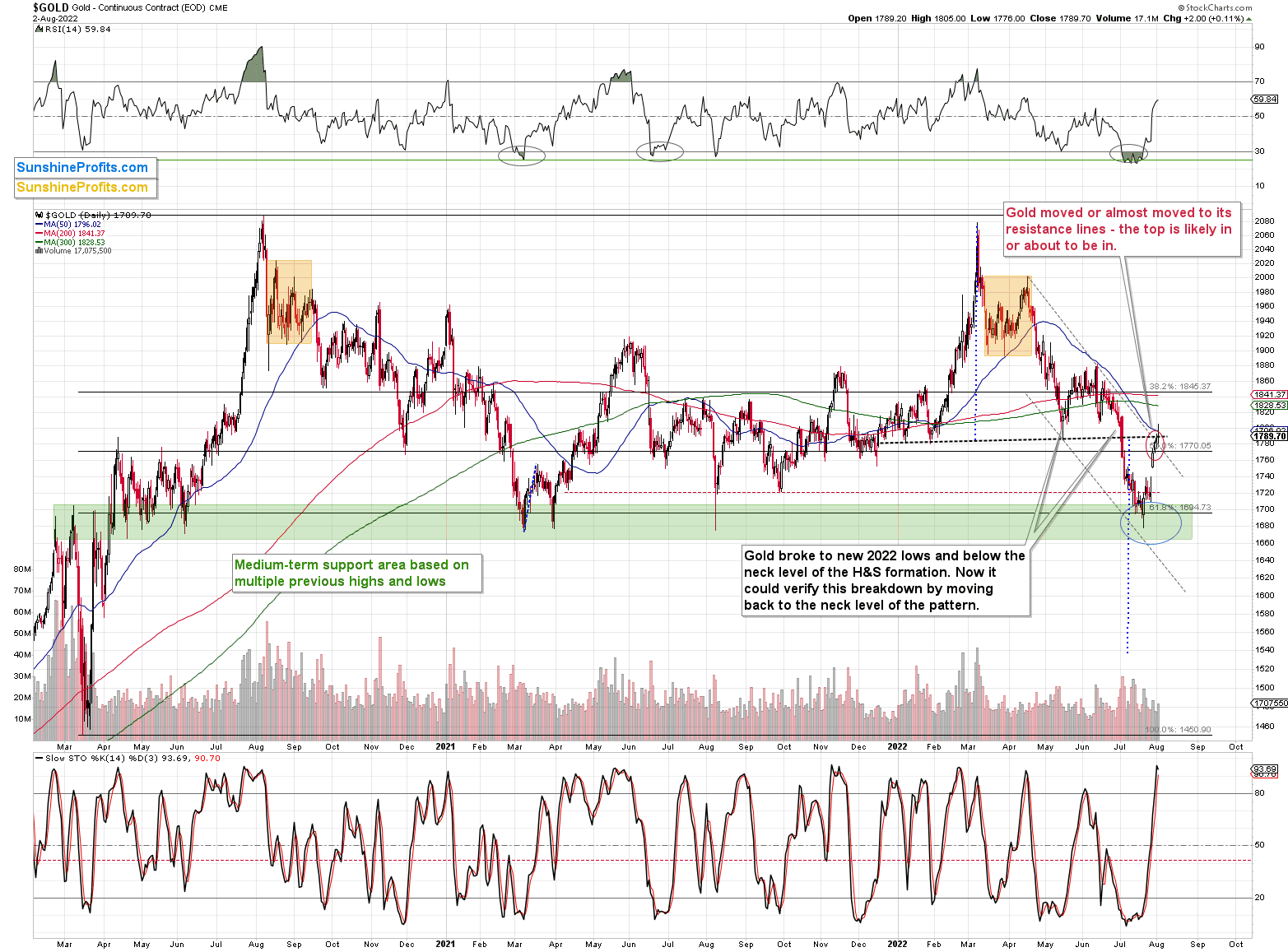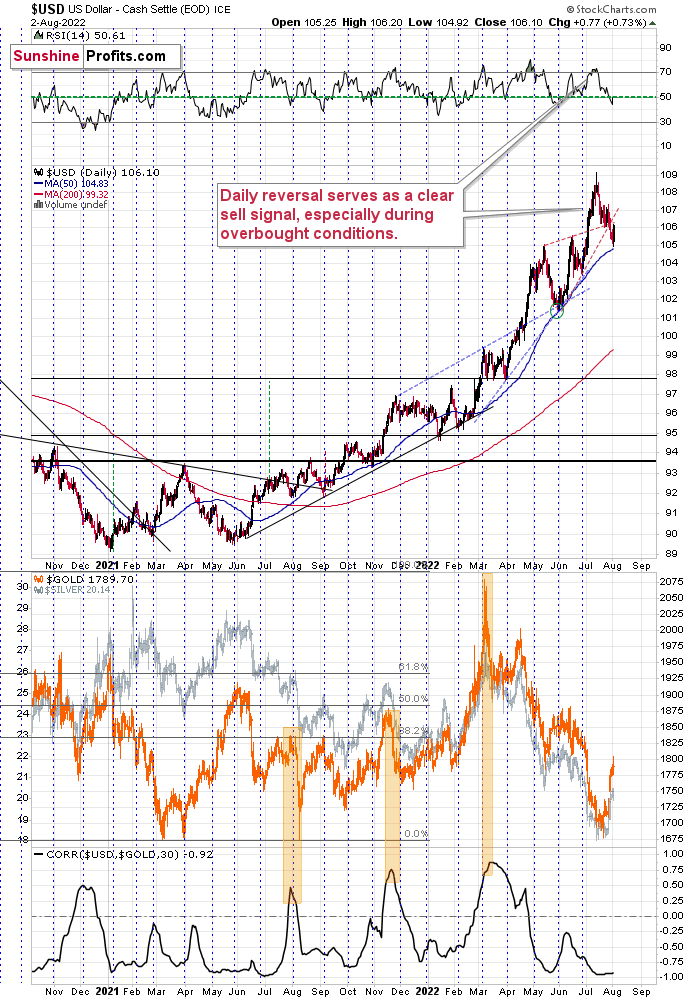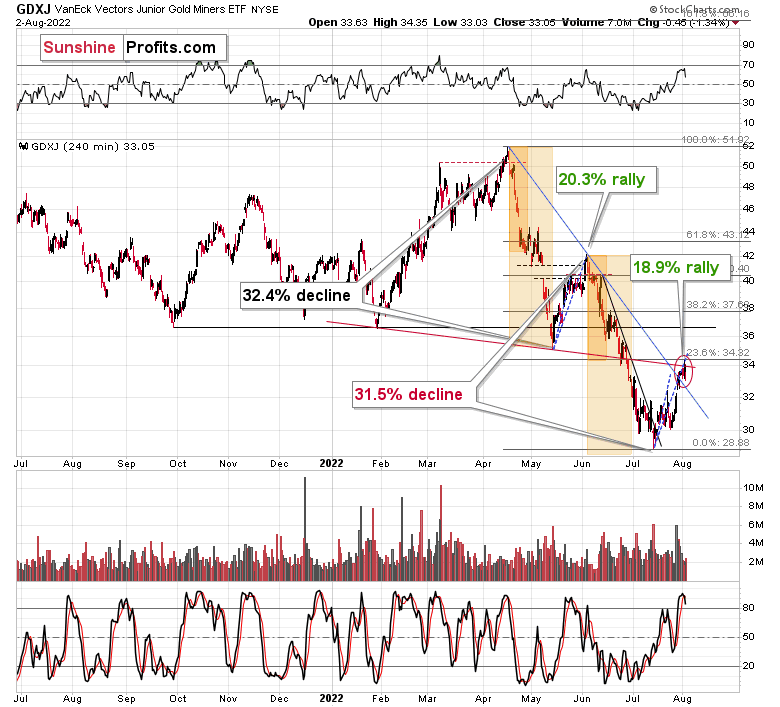Let’s start today’s analysis with a question that just hit our inbox, as it provides a good intro to today’s technical discussion:
Q: I really appreciate your services and technical support. Do you think the Pelosi/Taiwan news is giving gold and junior miners a bump? If so, how long will the bump last? It looks like Biden might be lifting China tariffs in exchange for Pelosi’s visit to Taiwan. What effects does lifting China’s tariffs have on PM and junior miners?
A: The bump is probably over – the visit had already started and there were no military repercussions.
If Biden is going to lift China’s tariffs, it’s likely to contribute to further declines in the precious metals sector. Why? Because it means greater cooperation and peace in general. Geopolitical conflicts tend to cause gold to rally, at least temporarily. Consequently, when conflicts de-escalate, it’s likely to remove some of the safe-haven appeal that gold (and the rest of the sector) has.
Please note how remarkable it is that technical tools can provide us with insights as to what’s likely to happen even before we get to know what the direct reason for a given move is.
How could that be the case? Because it is not the news itself that drives the price, but rather the news that is filtered through what people want to react to based on emotional/technical grounds.
You know what, let’s make today’s issue a bit more interactive.
In order to show you how the above works in practice, let’s do a quick exercise (no worries, you won’t have to even change the position in which you are at the moment of reading these words, and it will take less than 2 minutes).
Okay, please take 20-30 seconds or look around the room/space you are in right now and memorize all items that are red – as if you had to list as many as possible shortly.
Now, for the second (and final) part of the exercise, immediately after finishing this sentence (don’t look around again), please close your eyes, and check how many blue items you can recall (yes, blue, not red).
So, how was it?
Most people say that it was difficult to recall items in a different color because when they focused on one color, everything else was out of focus and was more or less ignored.
It’s the same with pretty much anything—including how the markets react to news.
When markets really “want” to move in a certain direction because of emotional/technical/cyclical reasons, it’s as if they were focusing on the “red items”. If a piece of news comes out that confirms this narrative (it supports the original expectation = “it’s red”), then the markets will react strongly. However, if they see something that contradicts it (against the narrative = “blue”), then they either react only a little, or not at all, or only briefly.
By the way, that’s why it’s a good idea to practice gratitude—one’s brain is then focused on noticing good things, and thus life becomes more beautiful and pleasant.
Yesterday’s news resulted in price moves that were likely to happen, not because of “magic”, but because these reversals (or something similarly bearish) were likely to happen anyway. The news just happened to fit.
However, since it’s not as simple as “gold reverses on Pelosi visit,” the majority of people writing about markets won’t be able to forecast the reversal beforehand.
Here’s what I wrote about the US dollar index previously:
This move is in tune with what we saw at previous local bottoms. The RSI moved slightly below 50, and it’s the turn of the month – this combination was enough to trigger rallies in the U.S. dollar index.
Let’s keep in mind that the latter tends to form important bottoms close to the middle of the year.
So, the scenario in which the USD Index bottoms shortly (or that it just bottomed) seems quite likely.
There’s also the possibility that the USD Index keeps declining until it reaches the very strong support at about the 104 level – the previous long-term highs. Right now, it’s at about 105.5, which means that it could decline by another 1.5 index points or so. It doesn’t necessarily mean that gold, silver, and mining stocks would need to rally substantially if the above materialized. Conversely, since gold might now be reluctant to react to the USD’s lead and miners might be reluctant to react to gold’s lead, it seems that the possible upside for junior miners is very limited.
In other words, even if the big decline really picks up in a few weeks, I think that the risk-to-reward ratio already favors being on the short side of the precious metals sector. In particular, on the short side of the junior mining stocks.
That’s exactly what happened.
The USD Index declined quite visibly yesterday, almost reached its 50-day moving average, and then rallied back up – very close to the turn of the month.
Was that the final short-term bottom? It might have been, but it could still be the case that it moves to 104 in order to bottom there. However, even if that happens, it won’t change the fact that gold didn’t want to react to lower USDX prices recently, and thus the additional decline in the USDX would only be likely to trigger back-and-forth movement in gold, not a profound rally.

The above gold futures chart doesn’t fully show the extent of yesterday’s decline (the data will likely catch up after today’s session), but it does tell us that gold just verified the move back to the neck level of the previously broken head and shoulders pattern. A decline from here will have profoundly bearish implications because, based on this pattern, gold is likely to decline to at least $1,540.
While the GLD ETF (NYSE:GLD) declined by 0.59% yesterday, the VanEck Junior Gold Miners ETF (NYSE:GDXJ) ETF declined by 1.34% (in terms of the daily closing prices).
After moving to the 23.6% Fibonacci retracement level and above the neck level of the previously broken head and shoulders pattern, the GDXJ declined, and ended the day 1.34% higher, thus making our short positions profitable.
The stochastic indicator flashed a sell signal, and there were only a few times this year when that happened, while the RSI was very close to the 70 level. That was at the March, April, and early-June peaks. These were all important tops, and the two most recent ones were followed by significant short-term declines. It seems that we’re likely to see one once again.
This means that my previous comments on the above chart remain up-to-date:
What’s also quite interesting on the above chart is the similarity between the recent upswing and the one that we saw in May and early June. In fact, even the timing relative to the days of the month is similar.
The previous rally started right before the middle of May, while the current upswing began just before the middle of July. The previous one consisted of two smaller rallies, which I marked with blue dashed lines and copied to the current situation. The first part of the move that we saw in July was not as big as in May, but the timing of the reversals was almost identical.
The second small rally is also aligned – at least so far. If this self-similar pattern is to continue, junior mining stocks are likely to top any day now, and the same goes for other mining stocks, silver, and gold. In fact, perhaps they have just topped.


